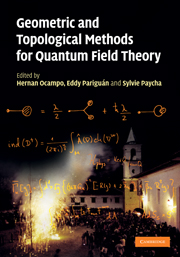Book contents
- Frontmatter
- Contents
- List of contributors
- Introduction
- 1 The impact of QFT on low-dimensional topology
- 2 Differential equations aspects of quantum cohomology
- 3 Index theory and groupoids
- 4 Renormalization Hopf algebras and combinatorial groups
- 5 BRS invariance for massive boson fields
- 6 Large-N field theories and geometry
- 7 Functional renormalization group equations, asymptotic safety, and quantum Einstein gravity
- 8 When is a differentiable manifold the boundary of an orbifold?
- 9 Canonical group quantization, rotation generators, and quantum indistinguishability
- 10 Conserved currents in Kähler manifolds
- 11 A symmetrized canonical determinant on odd-class pseudodifferential operators
- 12 Some remarks about cosymplectic metrics on maximal flag manifolds
- 13 Heisenberg modules over real multiplication noncommutative tori and related algebraic structures
2 - Differential equations aspects of quantum cohomology
Published online by Cambridge University Press: 07 September 2010
- Frontmatter
- Contents
- List of contributors
- Introduction
- 1 The impact of QFT on low-dimensional topology
- 2 Differential equations aspects of quantum cohomology
- 3 Index theory and groupoids
- 4 Renormalization Hopf algebras and combinatorial groups
- 5 BRS invariance for massive boson fields
- 6 Large-N field theories and geometry
- 7 Functional renormalization group equations, asymptotic safety, and quantum Einstein gravity
- 8 When is a differentiable manifold the boundary of an orbifold?
- 9 Canonical group quantization, rotation generators, and quantum indistinguishability
- 10 Conserved currents in Kähler manifolds
- 11 A symmetrized canonical determinant on odd-class pseudodifferential operators
- 12 Some remarks about cosymplectic metrics on maximal flag manifolds
- 13 Heisenberg modules over real multiplication noncommutative tori and related algebraic structures
Summary
Abstract
The quantum differential equations can be regarded as examples of equations with certain universal properties, which are of interest beyond quantum cohomology itself. We present this point of view as part of a framework which accommodates the KdV equation and other well-known integrable systems. In the case of quantum cohomology, the theory is remarkably effective in packaging geometric information, as will be illustrated with reference to simple examples of Gromov–Witten invariants, variations of Hodge structure, the Reconstruction Theorem and the Crepant Resolution Conjecture.
The concept of quantum cohomology arose in string theory around 20 years ago. Its mathematical foundations were established around 10 years ago, based on the theory of Gromov–Witten invariants. There are two approaches to Gromov–Witten invariants, via symplectic geometry and via algebraic geometry. Both approaches give the same results for the three-point Gromov–Witten invariants of familiar manifolds M like Grassmannians and flag manifolds, and these invariants may be viewed as the structure constants of the quantum cohomology algebra Q H*M, a modification of the ordinary cohomology algebra H*M.
However, the name ‘quantum cohomology’ may be misleading. On the one hand, the ‘quantum’ and ‘cohomology’ aspects are somewhat removed from the standard ideas of quantum physics and cohomology theory. On the other hand, there are strong relations between quantum cohomology and several other areas of mathematics: symplectic geometry and algebraic geometry, of course, but also differential geometry, the theory of integrable systems (soliton equations) and even number theory.
In this chapter we shall focus on the quantum differential equations as the fundamental concept (due to Alexander Givental [13–15]), which encapsulates many aspects of quantum cohomology.
- Type
- Chapter
- Information
- Publisher: Cambridge University PressPrint publication year: 2010
- 1
- Cited by



